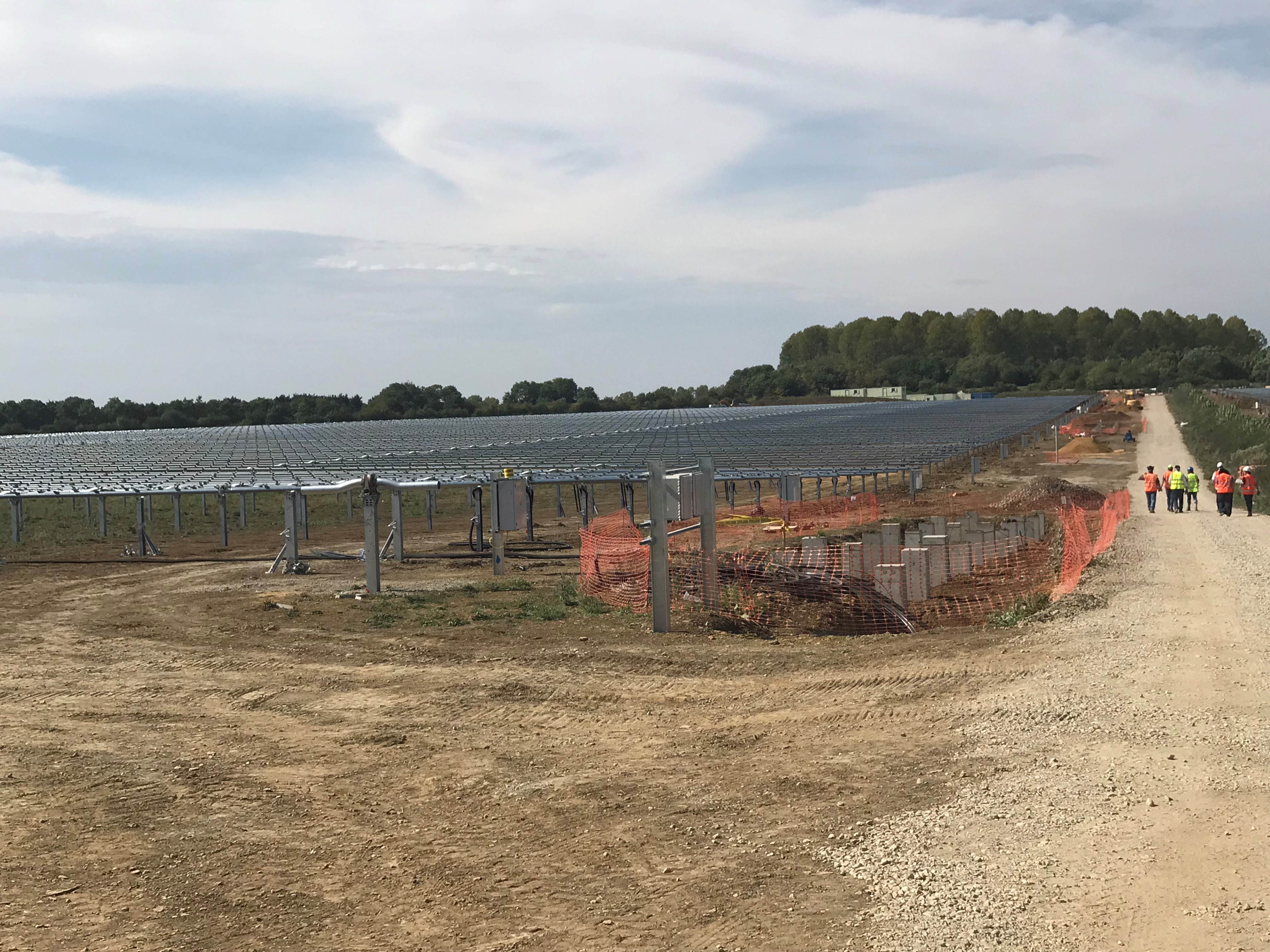20 Sep 2024
How is Action 8 tackling the climate crisis?
Councils that have declared a climate emergency may struggle to fund the measures needed to cut emissions in their area. Warrington Borough Council has piloted the use of community municipal bonds, a fundraising tool for local authorities, to fund renewable energy projects. Community municipal bonds allow councils to raise money directly from residents.
How do community municipal bonds work?
Bonds are issued by a council to members of the public, who can invest as little as £5 and get regular return payments on this investment. This is done via an online crowdfunding platform. Once enough has been invested, the council can give back to communities by using these funds to deliver low-carbon infrastructure and projects.
Warrington Borough Council announced its pilot bond scheme in May 2020. The bond was issued 3 months later and was made available to Warrington residents and others across the UK. It involved a collaboration with the ethical investment company Abundance, which administered the bond on behalf of the council. The bond was closed in November 2020, reaching its £1 million target 3 days before the set deadline.
"Fundamental to what we do at Abundance is that we want to make investing in local, place-based net zero infrastructure accessible – so a £5 minimum. We know that people want to move their money from destructive investments that they might hold, where they don’t know what their money is doing in the world, and put it to work to create the type of world they want to see – a more sustainable, socially just one. What we have tapped into with Warrington and other councils is people’s desire to have impact in their home environment and invest in their place.”
Karl Harder, Co-founder and Managing Director at Abundance Investments.
More than 500 investors contributed to the bond, with an average overall investment of £1,921. The bond was structured as a 5-year investment with a 1.2% return rate, making it competitive with high-street savings and investment opportunities. Return payments are made to investors every 6 months, with the option for these interest payments to be donated back to the council – 11% of Warrington investors did so with their first payment.
What impact has the project had?
Reduced emissions
Warrington Borough Council has used the funds raised to develop a 23 MW ground-mounted solar farm with an additional 40 MW battery storage capacity in Cirencester. Construction on the solar farm began in March 2021, with handover of ownership to the council taking place in September 2022, which is also when the farm became operational. The council anticipates that this solar farm will produce electricity above its annual energy consumption. There’s no generation data yet, but it’s expected that the project will produce 23,233,705 kWh of energy every year over its 30-year lifetime. The surplus will be sold to generate revenue, which'll be used to advance the council’s Green Energy Strategy.
Warrington Borough Council owns 2 other solar farms, which give a good indication of carbon savings. The York site, which is 50% larger than the Cirencester site, has generated approximately 23,000 tonnes of carbon savings since the council took ownership in December 2019. The Hull site, which is slightly bigger than Cirencester, has generated approximately 11,700 tonnes of carbon savings since the council took ownership in October 2020.
Better buses
Warrington submitted a successful bid to the Department for Transport’s Zero Emission Bus Regional Areas (ZEBRA) scheme, which'll dispense £120 million to support the introduction of zero-emissions buses. Warrington’s share is £21.5 million and will be used to electrify its buses.
The new electric bus fleet will be powered with green energy, of which the borough’s supply has been increased by the solar farm at Cirencester. The energy provided by the farm would be enough to charge the whole fleet of all-electric buses. The weaving together of the community municipal bond, the solar farm and the electrified buses was Warrington’s unique selling point and made for a stronger funding bid to the ZEBRA scheme.
With this funding, the council will replace the entire fleet of its municipally owned bus company, Warrington’s Own Buses, with 120 electric buses. The company – which covers 85% of bus mileage in the borough – will be moved to a new depot, and the bus service will be modernised to improve reliability, with the aim of getting more Warrington residents out of their cars.
The council has also been granted an additional £16 million in Bus Service Improvement Plan (BSIP) funding from the Department of Transport to make buses cheaper, more regular and reliable, faster, easier to use and better integrated.
“It feels like we are at the front of doing something that pretty much everyone else is going to have to do at some point, and not just for buses but everything. It’s exciting to be that close to the front of a project like that.”
Ben Wakerley, Managing Director of Warrington’s Own Buses.
Community energy and fuel poverty
The revenue from the solar farm will reduce fuel poverty by contributing towards the council’s own fuel poverty charity, the Warrington Community Energy Trust. With ongoing cuts to councils, it’s important that they find new ways to fund measures to tackle fuel poverty, including supporting community energy projects.
The 15% of interest payments (as of July 2022) being donated back to the council by bond investors are being channelled into the charity – amounting to approximately £7,000 per month. As a result, the Trust has become more active in the community and is now looking to hire several new fuel poverty advisors. The new funds benefiting the charity will also go towards other forms of grassroots climate action in the community, such as ecology gardens in local schools and tree planting.
Warrington has shown how the benefits from municipal bonds can multiply – not only directly funding climate action, but also drawing in greater revenue for more wide-ranging action in multiple policy areas.
The scheme has raised the council’s profile and improved its reputation among members of the public – investors reported that the scheme gave them a more favourable view of the authority. Through their investment, more residents are now engaged in efforts to address the climate crisis. The council has therefore cultivated a pool of residents more likely to participate in its other net-zero projects, and who may also be relied upon as future investors. On this foundation, there's potential for Warrington to issue more bonds that provide a regular stream of income over the next 5-10 years.
What made this work?
Commitment
Warrington Borough Council has a long history of strong climate ambitions. In 2007 the council launched its first climate change strategy. From 2009 to 2019 Warrington reduced its carbon emissions from its own operations by over 50%. More recently, Warrington has declared its aim to become the first carbon-neutral town in the UK.
Expertise and vision
The council boasts previous experience in solar farms, with 2 already in operation at Hull and York. The council, therefore, has strong institutional expertise in and passion for innovating on green issues, making it well-placed to become a pilot case for the use of community municipal bonds. It also had experience in raising a city bond, 5 years prior, to fund regeneration of the town centre. Other councils can now benefit from this experience, as well as resources produced about using community municipal bonds (see below).
Partnership
The council’s partner Abundance structured the bond to make it as low-maintenance as possible for the authority.
A strong business case for councils and residents
The bonds are a win-win for councils and residents. For the council, they're an easy way to diversify funding sources and cut reliance on less stable traditional borrowing channels such as the Public Works Loan Board. The debt presented to the council is similar to the Public Works Loan Board borrowing rates. As the bonds are offered and managed online, they're efficient and logistically simple for the council to run.
For residents, the bonds are a low-risk investment, because risk is tied to the strength of the council, not to the success of the project. Investors don't assume the risk if a given initiative fails or is delayed. The robustness of councils compared to high-street banks makes this a relatively risk-free way for residents to mobilise their money.
"We have found the bond to be a very, very successful process which has led to engagement with the community. Typically, there is little interest in council services unless someone’s bin doesn’t get emptied, so it was nice to have a positive form of engagement that gave us access to different people in the community. We have been taken aback by the number of investors choosing to donate their interest and the amount of money coming back to the council.”
Daniel Mather, Head of Corporate Finance at Warrington Borough Council.
Clear social impact
Standard investment products available at banks are often hard to understand – people don’t always know where their money is going. By contrast, community municipal bonds are very transparent, as residents can see the result of their investment, whether a solar farm or new electric buses. Investing in bonds offers people clear benefits for themselves and their local community.
Accessibility
With a minimum investment of £5, these bonds are very socially inclusive (although smaller investment equals smaller returns). They also offer an alternative channel to democratic public forums like climate assemblies, which some residents may feel reluctant to participate in. Such bond schemes allow a wider range of people to contribute to local climate action.
Resident’s sense of identity
Warrington residents are strongly attached to their town, which perhaps encouraged them to invest in it.
Economic health
Warrington is wealthier than many other UK cities and towns, with an unemployment rate of 3.2%, below the national average. This suggests that Warrington residents likely had disposable income available to invest. However, Warrington was hit especially hard by the coronavirus pandemic, with an inevitable impact on its economic wellbeing. The bonds offer a new way for residents to improve their financial security.
What resources were needed?
Daniel Mather, Head of Corporate Finance, Andy Doyle, Finance Manager, and Adam Simpson from the legal team were the leads from Warrington Borough Council. They were advised by Charlotte Eddington, Investments Director at Abundance. Abundance was already known to the council through previous work on financing other projects.
The only direct cost to the council was about £12,000 in legal costs, and 15-20 hours of staff time.
The bond was officially announced in May 2020, but discussions with Abundance had begun 9-12 months earlier. At this time, Abundance was also running a similar pilot project in West Berkshire. To avoid releasing 2 versions of the same product onto the market at the same time, Warrington’s bond was planned for release after the West Berkshire one had first been launched. If the scheme is repeated, the 9-12-month development period could be much shorter.
Lessons from Warrington
Build consensus early on
Setting up and implementing the bond ran smoothly with few hurdles. Early on, there was some doubt from opposition councillors. Warrington is a Labour-held council with a healthy Liberal Democrat and Conservative opposition. The wisdom of launching a bond when the council was focused on fighting the COVID-19 pandemic was questioned. However, once the financial details were fully explained, councillors became supportive – the Liberal Democrats in particular have been very supportive of Warrington Labour’s green agenda. Warrington’s example proves that a community municipal bond can be a tool for a just, fair and green recovery. Moreover, even during the hardship of the pandemic, the target of £1 million was comfortably reached, testifying to the importance local people give to taking on the climate emergency.
Get the paperwork in order
When considering implementing a community municipal bond, councils should include this intention in their annual Treasury Management Strategy. This is an important document that outlines how an authority will manage its accounts and where it’ll invest money in the coming year. Including provision for a bond in the strategy is a small detail that could be easily overlooked but avoids later bureaucratic hurdles. If the bond is included, then the council can act to establish one when a good financial opportunity arrives. However, if it isn’t included, officers must return to elected councillors for approval, a time-consuming process by which point the opportune conditions for a bond may have passed.
Emphasise the local benefits
The council is considering more bonds to finance future projects. But it'd like more local buy-in and to grow the number of residents contributing. Abundance handled the communications for the first bond, but more council involvement in communication and media strategy could push the local green benefits of the bond, ideally getting more people on board at an earlier stage.
Be aware of any financial risk to the council
Funding struggles are one reason why these bonds may appeal to stretched local authorities. But for investors, risk is tied to the continued existence and financial strength of the council. Any councils at risk of a Section 114 notice being issued due to failure to balance budgets – a legal order that restricts their spending – will be unable to implement a community municipal bond. Abundance credit checks councils to ensure that investors aren’t lending to authorities at risk.
For financially sound councils, there's still risk to consider. If there are serious project complications or setbacks, they'll carry the risk as opposed to investors.
Can this be replicated by other councils?
The success of the pilot in Warrington led the Green Finance Institute and Abundance to launch a national campaign in July 2021 to help local authorities set up community municipal bonds. The Institute is targeting all 404 local authorities in the UK. In September 2021 5 councils signed the Local Climate Bond Pledge, committing to issuing a bond by summer 2023. Warrington has been approached by and offered advice to other councils interested in a bond, including Islington Council, Birmingham City Council and Solihull Council.
Spending possibilities for community municipal bonds include making homes more energy efficient, installing charging points for electric vehicles, and rewilding and tree-planting projects.
Bonds could be used to engage and protect vulnerable communities or boost green skills and jobs – they're flexible and can be moulded to specific council objectives.
Authorities might feel they lack the knowledge and experience to launch a similar bond, but the concept is simple and straightforward. The University of Leeds team have produced a local authority crowdfunding decision-making flowchart to help councils determine whether a community municipal bond is right for them.
"A bond like this is easier than you might think. Abundance really do know what they’re doing. It's a way of trying to get local buy-in for residents to understand what the Council is doing and for residents to be able to invest back into their own services. It really is about that mutual benefit."
Lynton Green, Deputy Chief Executive and Director of Corporate Services at Warrington Borough Council.
Useful information
Information in this case study was sourced from the report "Community Municipal Investments: Accelerating the Potential of Local Net Zero Strategies", authored by Mark Davis. Read a further report by PCAN, "Community Municipal Bonds: Turning words into action".
If you're interested in setting up your own community municipal bond, please contact:
Related projects
We've found some examples of other council activity on this topic.
- West Berkshire Council has used community bonds to fund solar panel projects.
- Other councils that've committed to developing local climate bonds are Telford and Wrekin Borough, Blaenau Gwent County Borough, Cotswold District, Camden, Westminster, Lewes District and Eastbourne Borough.
Friends of the Earth's view
It’s encouraging to come across councils that've found innovative ways to raise money for climate action, and community municipal bonds seem particularly promising. Meanwhile, Friends of the Earth will keep campaigning with our Blueprint allies for the additional long-term funding councils need from the UK government to tackle climate change.
In Warrington it’s great to see the council making the links between its solar-power generation and other low-carbon projects, as well as re-investing in the community.
Councils can also raise money using planning mechanisms such as the Community Infrastructure Levy (Action 9 of the Climate Action Plan).
Friends of the Earth is showcasing specific examples of good practice in tackling climate change, but that doesn’t mean we endorse everything that council is doing.
This case study has been produced by Ashden and Friends of the Earth. It was originally published in February 2022 and was last updated in December 2022. Any references to national policy in this case study relate to policy under the previous government and reflect the policy context in which the council was operating at the time.







